For those with sensitivities to gluten - this loaf is for you. A tried and tested and widely loved Gluten Free Buckwheat & Millet Bread. This comes out soft and spongy and keeps well in a bread bag on the kitchen bench.
Updated 17 July 2019.
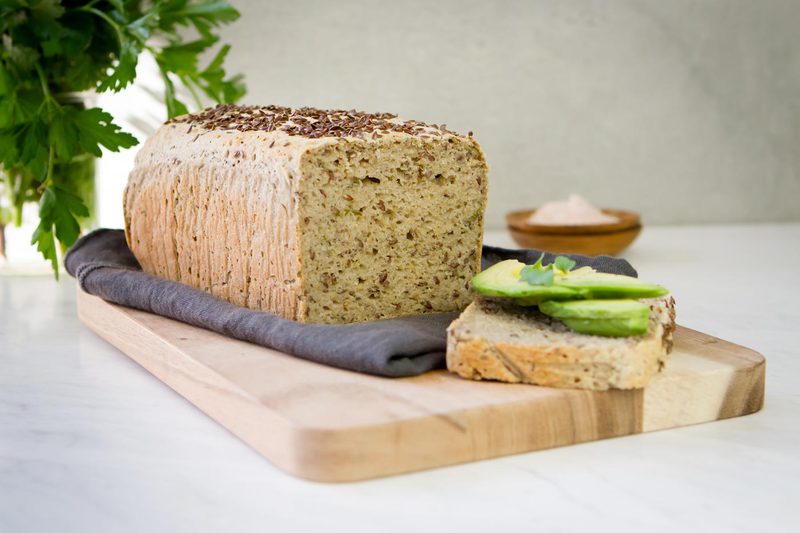
Allergen-Friendly Buckwheat Millet Bread
Based on the number of people with gluten sensitivities I have seen so far in clinic, I thought it would be a great idea to create a classic gluten free loaf to recommend to clients making the transition to a gluten free diet.
Update: I've since also made a fabulous raisin bread - it's a must-try!
Firstly – there are so many neat ways you make a healthy bread – you can soak your grains first (great!), you can then go on to sprout them before bread making (as in Essene bread – also great!), or you can ferment your bread, sourdough style.
All these methods of preparation are fabulous as they help pre-digest the grains, neutralise anti-nutrients, and have the net result of making them that much more digestion-friendly.
The downside – time. Yep, I totally get it’s just too huge a leap to get straight into these more complex methods of preparation - especially when you have a hungry family. You want bread - you want it today!
So – where to start? With a delicious fuss free loaf made from store bought gluten free flours, using yeast to help it get a decent rise and provide enough aeration to make the end result soft and springy – and, well, comforting!
Because that’s why we eat bread, no?
[bctt tweet="Soft & spongy Gluten Free Buckwheat & Millet Bread, with flax and rosemary. Recipe here!"]
Making Buckwheat Millet Bread
This recipe uses a blend of two high protein gluten free flours: buckwheat and millet, in addition to tapioca starch, it works out roughly as two thirds high-protein GF flour to one third starch.
I’ve found this to be the sweet spot of gluten free baking. The high protein flours mimic gluten, while the starch improves the texture – helping add some ‘spring’.
Buckwheat and millet can be exchanged for other high protein gluten free flours if you want to mix it up a little.
In fact, I made a sweet version of this loaf using sorghum in place of millet – I think as long as you interchange the flours based on weight rather than cup measurements, you’ll be fine (eg, millet is quite dense and weighs more than the lighter, fluffier sorghum).
Tapioca is made from the root of the cassava plant. The brand I use (Ceres) is organic, and has not been chemically bleached.
You could use potato starch or green banana flour in place of tapioca – just be aware that both of these are a type of resistant starch that are fantastic for your gut but can make you prone to, erm, gas.
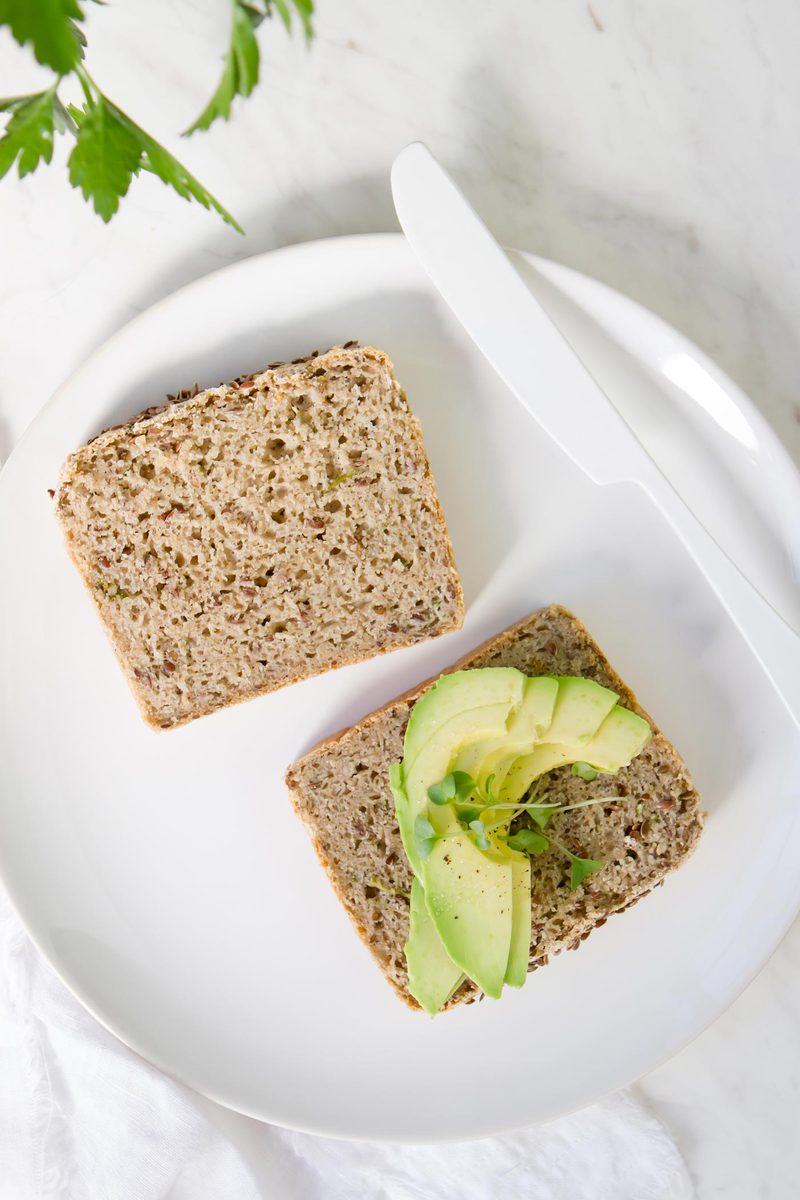
The yeast I used is an active yeast bought from my local organic store. I keep it in the fridge to keep it fresh. After many a bread-making-trial, I can add this gem: old yeast will not rise nearly as well as fresh. The yeast wakes up in the warm water and feeds off the sugar.
Once baked, it dies off and so is not active any longer.
The other great thing about this recipe – is its super allergy friendly – containing no dairy or eggs. I have a raging rosemary bush in the garden, so snipped a few decent sized tendrils and added a liberal amount of the fresh leaves to the mix.
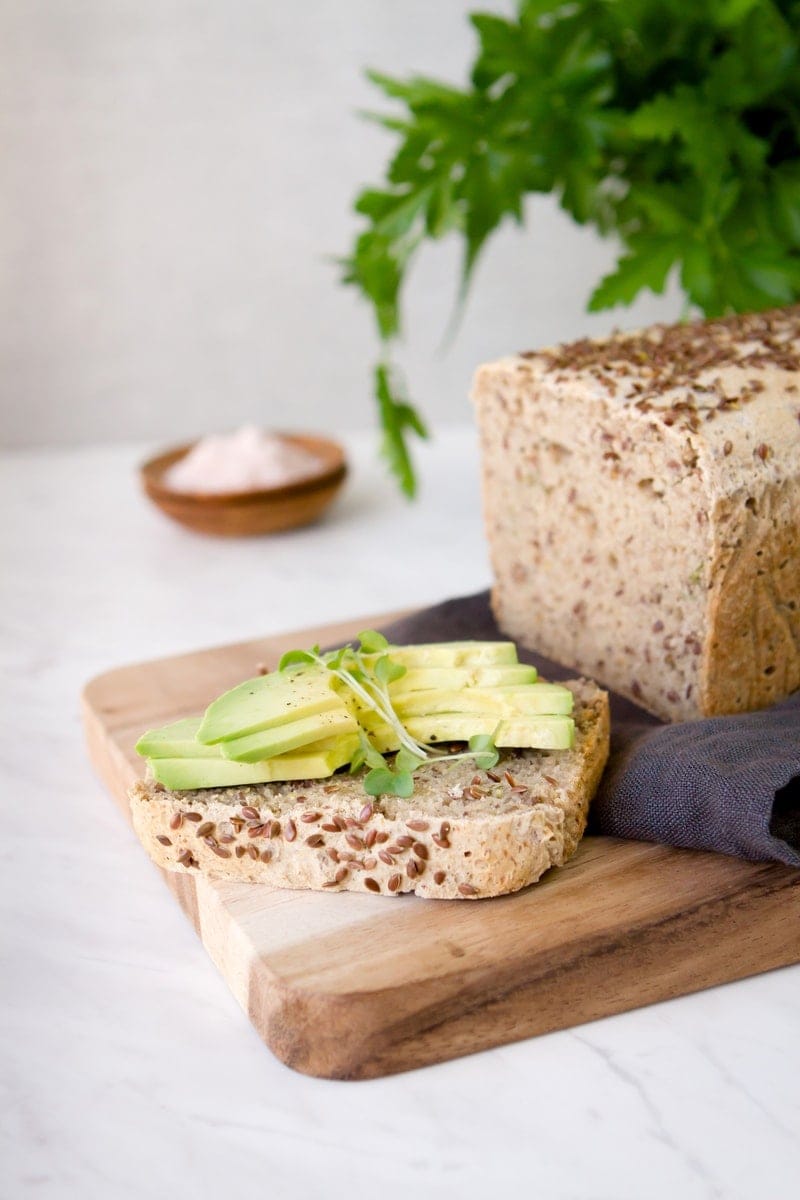
Buckwheat Millet Bread Flavour Alternatives
This is a basic recipe, but some mad flavouring ideas to make it a bit more special are below:
- A teaspoon of turmeric powder for colour and anti-inflammatory compounds
- A couple of pinches of spirulina for the minerals if you don’t mind a green bread
- A few tablespoons of karengo fronds (New Zealand native nori), dulse flakes or a torn nori sheet – again for the minerals and a subtle salty-ness
- Hemp seeds for extra protein
- Slippery elm to help soothe the gut
- Fresh herbs – coriander, parsley, mint, basil
- Edible flowers – calendula, dandelion
You might also like to try my raw Ginkgo Pesto or Homemade Mustard recipes out - they'd make for great toppings.

Finally – once you’ve combined all ingredients in a bowl and mixed to form a dough (no kneading is required since there is no gluten), it takes an hour to rise in a warm environment and up to 40 minutes to bake.
I think this is such as great thing to make on a weekly basis – and it will certainly save you money.
Enjoy!
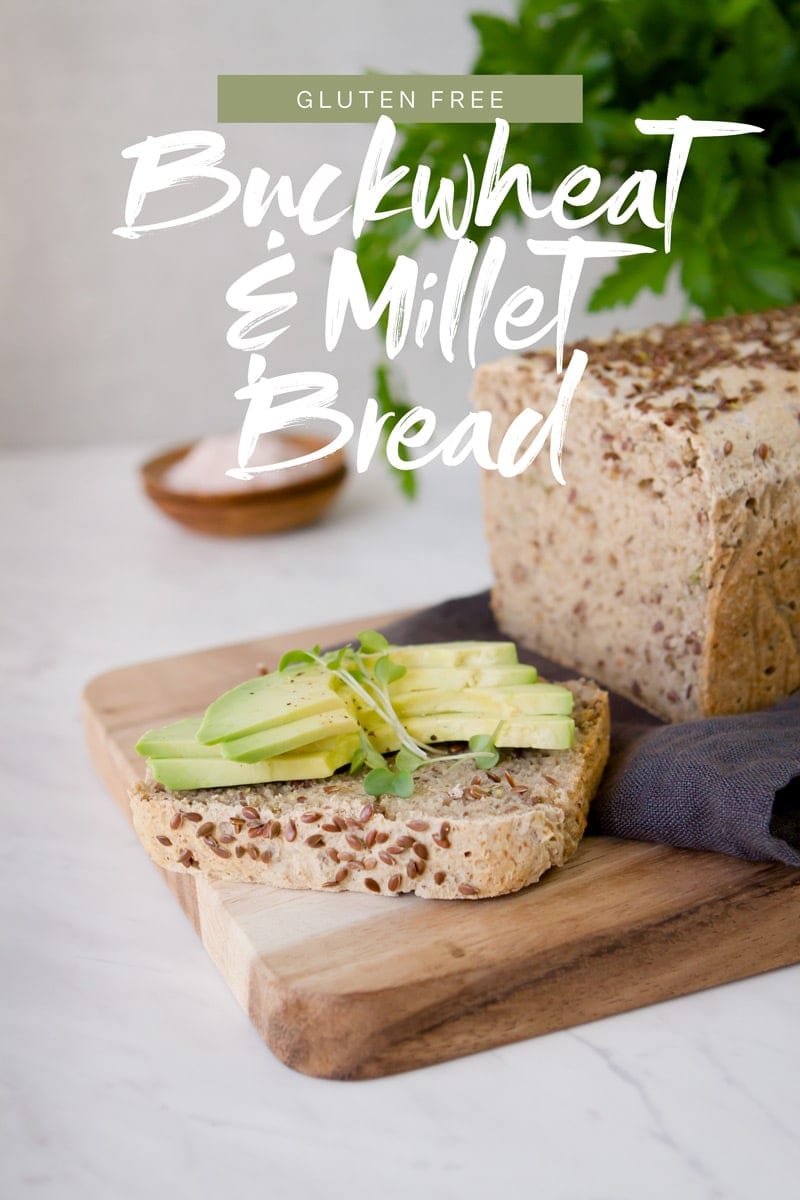
If you make and enjoy this recipe, please leave a rating below. And better yet – leave me a comment to tell me how you got on, or just say hi – I LOVE hearing from you. Follow me on Instagram, Facebook or Pinterest to see more of my everyday recipes and wellness tips.
If you’d like to chat with me about essential oils, or book in a class, you can do that here. If you’re after a Naturopathic consult, read more here.
📖Recipe
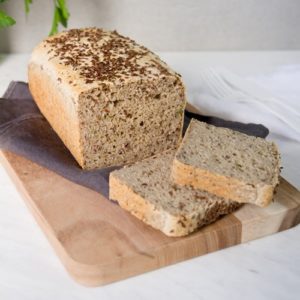
Gluten Free Buckwheat Millet Bread
Ingredients
- 1½ cups (approx. 225g) buckwheat flour
- ½ cup (approx. 100g) millet flour
- 1 cup (approx. 130g) tapioca starch
- 2 teaspoons baking powder source a gluten free brand
- ¼ cup whole flax seeds also known as linseeds
- ½ teaspoon sea salt fine
- 2 fresh rosemary sprigs
- 2 tablespoons extra virgin olive oil
- 2 tablespoons psyllium husks
- 2 cups warm water
- 2 teaspoons active yeast ensure it is fresh
- 2 teaspoons sugar to feed yeast
TO FINISH:
- Flax seeds
Instructions
- Line a rectangle bread tin with baking paper and set aside.
- Add sugar and yeast to ½ cup warm water, give a little stir, and set aside for ten or minutes until the yeast blooms and froths.
- Meanwhile, sift the buckwheat and millet flour, tapioca starch, baking powder and salt into a large mixing bowl. Add flax seeds. Tear the leaves from the rosemary sprigs and add those as well. Mix to combine.
- In a blender, whiz the remaining 1½ cups warm water with the psyllium husks for 10 seconds and no longer (otherwise the mixture will get too thick). Make a well in the centre of the dry ingredients, pour in psyllium husk mixture, olive oil and yeast mixture.
- Use a spatula to fold the mixture together in what I call a ‘batter-dough’ as it really is a mix of both!
- Pour 'batter-dough' into bread tin. Place a layer of cling wrap snuggly over the surface. Place bread tin in a warm spot and let rise for around an hour. This may take longer in colder weather. If room temperature is too cool, try my bread rising hack: warm a heat pack up and wrap in a towel, then sit bread tin on top. The trick is to keep a constant temperature – not too hot – otherwise the bread will rise too fast and collapse in the oven.
- After an hour, remove cling wrap and place bread tin in a hot oven. Bake (force fan) at 180˚C/356˚F for 35-40 minutes.
- Once cooked, remove from bread tin and let cool entirely before slicing with a serrated knife.
Notes
- This recipe uses a blend of 2/3 high protein gluten free flour to 1/3 starch, I think this is the sweet spot for baking a loaf like this. The high protein flours mimic gluten, while the starch helps improve the texture. Therefore, you could try substituting the buckwheat and millet for another high protein flour, like sorghum.
- Coconut flour will not work - it is far too dense, you won't get any rise.
- Choose an organic tapioca flour, as typically they are bleached.
- Potato starch is an alternative to tapioca, however, this can trigger people with IBS (gut bacteria LOVE to feed off potato starch!).
- I'm sorry but there are no alternatives to the psyllium husk - this is used as an alternative to eggs. One reader tried ground chia and reported the bread was gritty - chia are dark so they'll also discolour your bread.
- I've already made so many tweaks and substitutions to this recipe to make it allergy-friendly - there isn't much wriggle room for you to further faff with the recipe, otherwise I can't promise you'll get a good result!
- Your yeast must be FRESH. If it isn't, it won't bloom, and your bread won't rise.
- Coconut sugar can be used in place in regular sugar, however it will change the colour of your bread. I've tried both, and prefer white sugar - there is minimal in the final loaf as the yeast will consume most of it.
- The bread really needs a constant warm environment in order to rise, in cooler climates, try turning your oven on for a few minutes to heat it up, then turn it off, and place the bread on a rack in the centre, close the door and let it rise in there.
- Alternatively, try my hack: heat a wheat bag, wrap it in a towel, and rest the bread tin over the top.
- If the bread rises too quickly too soon (it will do this if the temperature is too warm), then it will flop.
- If you open the oven door while the bread is baking, it will flop.
- This bread is best stored wrapped snuggly in a breathable paper rather than plastic, and will stay soft on the counter for days (possibly longer - it always seems to get eaten so quickly!).





frisk
This sounds great! Think it would work to substitute with chickpea or coconut flour?
Amalis Riera
Can this be made in a bread machine? What would be the adaptation to the recipe?
kemiim
I'm trying to downsize the GF starches, gums, and grains for baking. Psyllium husks is not among my items, nor would I like it to be, so what substitutes could replace this item is this awesome looking recipe? Thanks.
Amy Nigh Leitheiser
I made this bread and was so excited to have it as toast because I'm doing an elimination diet. I really liked the texture of the bread but want to work on some other flavors to develop. I will try the version with raisins- that looks really good. Thank you so much. This is the first gluten free bread that has ever worked out for me. I milled my own millet and buckwheat flour fresh!
Lorena Agramonte
Hi! Can you sub sugar for coconut sugar?
Best,
Lorena Agramonte
Elizabete Vieira-Pereira
my husband cannot have flax seed and psyllium husks. What shiuld I use as a substitute? Thnx
Kathryn Chalmers
Thank you very much for this recipe. Came across it in a search as I am avoiding lots of foods in an effort to heal my gut. Best gluten free bread I have ever had easily-only problem being I want to eat it too quickly! Have made a handful of times now.
Thank you thank you!
Ascension Kitchen
Awesome Kathryn! So happy to hear you love it! Gotta have a good bread recipe up the sleeve 🙂
Melanie Bell
I just made this and I'm so impressed! Thank you so much. This is the only bread recipe I've found with none of my numerable and recently diagnosed allergies. So relieved I can still eat something! (PSA: for those allergic to corn, I looked up a baking powder recipe that substitutes tapioca starch for corn starch and it seems to have worked just fine).
Mine did also come out black in colour like another commenter, but I think it's just a difference in buckwheat flours. It was also less of a batter-dough and more just straight dough, so I don't think it has as much rise as it could have. Should I just be adding more water to future loaves?
Can't wait to try more recipes on this site. You're my hero.
Ascension Kitchen
Woooohoo! Bread making success! Glad you enjoyed. I'm curious about the colour - did you by chance use coconut sugar? Yes I imagine a bit more water might make the mixture lighter and able to rise better, also, fresh yeast is the name of the game. 🙂 Lauren.
Michelle Marx
Hi I'm just wondering if you could make this bread in a bread machine?
Laura Campbell
Rainy day here in the Pacific Northwest and I wanted to make this bread. However I do not have psyllium husk in my kitchen. Do you think chia seeds would substitute or maybe something else? Thank you
Ascension Kitchen
Hi Laura - I haven't tried it without the psyllium - it's acting as a binder - I wonder if just one tablespoon of ground chia seeds would do the trick in place, I think you may have to experiment but please report back!
Laura Campbell
I tried it. My loaf came out very dark grey and not spongey or tall like your photo. It did rise, however. The taste is bland and gritty and a bit raw. I weighed every ingredient. It was a fun experiment and I thank you so much for your response. Probably not going to go for this one again but most of your other recipes always turn out spectacular.
Cindel Jane
Hi Lauren, do you know if I can use arrowroot powder instead of the tapioca? Thanks so much 🙂
Ascension Kitchen
Hi Cindel - I don't know! But if you're up for an experiment please let me know how it turns out! They are both starches so it should be just fine, I just haven't used it before myself.
Nina Howes
Hi there, I just have a question, I made this recipe however my bread did not rise in the oven, I used a hot water bottle to keep it warm and placed it underneath the tin (would that make it too hot). Also when you mean batter the dough, I just used my hands and sort of kneaded the dough? Sorry for the abundance of questions I just want to get it right 🙂
Ascension Kitchen
Nina I apologise I missed your comment - the bread needs consistent warmth for it to rise, but too much heat will cause it to rise too quickly, then the air bubbles will collapse and it will flop. It's a delicate balance. If you open the oven before it has cooked it may flop also. The freshness of your yeast also matters - if it is old, it won't rise. In regards to the dough - no I didn't mean to knead it - I just called it a 'batter-dough' as it a mix between a soft batter and a firmer dough in consistency. All you do is transfer it straight into the baking tin. Hopefully that helps?
Nina Howes
No worries, think I have got the knack of it now :))))
Also would love to know if you would recommend any online short courses about herbs of superfoods .. there are so many out there and wasn't sure which one to choose - any insights would be deeply appreciated :))
Ascension Kitchen
Hi Nina - I can't think of any on superfoods but can suggest a couple for herbs - as in herbal medicine rather than culinary use of herbs - is that what you are after? Feel free to email me as I can share the info in a bit more detail than here in a comment.
Rebecca
Hello, I wonder if you can suggest an alternative for the millet flour? I can't find any in my local stores (supermarket or health food) and I'd love to give this bread a go.
Thank you 🙂
Rebecca
I see the fruit spiced loaf has sorghum flour instead. Would that work or would it be too sweet?
Ascension Kitchen
Hi Rebecca, sorghum flour (also called sweet sorghum) will work great - I haven't tried brown rice flour yet but I'm sure it would also work. I think the key is to sub out the flour gram for gram rather than cup for cup as they all weigh a bit differently. Other options are quinoa or amaranth flour though I personally find them a little bitter / grassy in taste - you could try using a blend of both to get around this. Another tip is to make sure the 'dough-batter' is a little on the batter side rather than dough - the lighter the mixture the better rise you will get. Hope you enjoy 🙂
Ascension Kitchen
Sorry meant to add - if the mix does feel more dough like with the alternate flour added, just add water little by little to get the right consistency.
MACIEJ PIOTROWSKI
What consistency the dough should be? You have mention to pour the dough, mine was dry and fairly solid, I could hold it in one hand in a form of roll. I've checked my proportions and followed exactly the recipe.Help!
Lauren Glucina • BNatMed, AdDip NutMed
Hey Macie - a cross between a cake batter and a bread dough, so leaning to the thinner consistency, it shouldn't be dry or solid at all, you didn't double up on anything by chance? Hope it still turned out!
Irena Macri
This is perfect since we just ended our 9 week Happy Body Formula program, and some of the participants are really missing bread! I will be passing on this recipe!
valentina | sweet kabocha
Amazing gf bread!! I've a question for you : the flax seeds covering the bread, aren't they prone to oxidation due to the hot temperature of baking?
Ascension Kitchen
Hi Valentina 🙂 I'm not sure - antioxidants can be destroyed by heat, but I'm not sure what temperature flax in particular can endure. I do know that the alpha linolenic acid content does not seem to be affected by baking, although its far more bioavailable when consuming raw, ground flax. Flax seed oil for sure oxidises quickly and needs to be kept in the fridge x
valentina | sweet kabocha
Thanks so much for your answer ^_^ Have a wonderful weekend!
xo